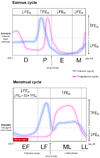Sex differences in fear extinction
- PMID: 31129235
- PMCID: PMC6692252
- DOI: 10.1016/j.neubiorev.2019.05.020
Sex differences in fear extinction
Abstract
Despite the exponential increase in fear research during the last years, few studies have included female subjects in their design. The need to include females arises from the knowledge gap of mechanistic processes underlying the behavioral and neural differences observed in fear extinction. Moreover, the exact contribution of sex and hormones in relation to learning and behavior is still largely unknown. Insights from this field could be beneficial as fear-related disorders are twice as prevalent in women compared to men. Here, we review an up-to-date summary of animal and human studies in adulthood that report sex differences in fear extinction from a structural and functional approach. Furthermore, we describe how these factors could contribute to the observed sex differences in fear extinction during normal and pathological conditions.
Keywords: Extinction; Fear; Female; Human; Male; Rodent; Sex.
Copyright © 2019 Elsevier Ltd. All rights reserved.
Conflict of interest statement
Declarations of interest: none
Figures


Similar articles
-
Contribution of estradiol levels and hormonal contraceptives to sex differences within the fear network during fear conditioning and extinction.BMC Psychiatry. 2015 Nov 18;15:295. doi: 10.1186/s12888-015-0673-9. BMC Psychiatry. 2015. PMID: 26581193 Free PMC article.
-
Sex-specific neuroanatomical correlates of fear expression in prefrontal-amygdala circuits.Biol Psychiatry. 2015 Aug 1;78(3):186-93. doi: 10.1016/j.biopsych.2014.11.014. Epub 2014 Nov 29. Biol Psychiatry. 2015. PMID: 25579850 Free PMC article.
-
Sex differences in learned fear expression and extinction involve altered gamma oscillations in medial prefrontal cortex.Neurobiol Learn Mem. 2016 Nov;135:66-72. doi: 10.1016/j.nlm.2016.06.019. Epub 2016 Jun 21. Neurobiol Learn Mem. 2016. PMID: 27344940
-
Mechanisms of estradiol in fear circuitry: implications for sex differences in psychopathology.Transl Psychiatry. 2014 Aug 5;4(8):e422. doi: 10.1038/tp.2014.67. Transl Psychiatry. 2014. PMID: 25093600 Free PMC article. Review.
-
Fear extinction as a model for translational neuroscience: ten years of progress.Annu Rev Psychol. 2012;63:129-51. doi: 10.1146/annurev.psych.121208.131631. Annu Rev Psychol. 2012. PMID: 22129456 Free PMC article. Review.
Cited by
-
Reactivation of the Unconditioned Stimulus Inhibits the Return of Fear Independent of Cortisol.Front Behav Neurosci. 2019 Nov 12;13:254. doi: 10.3389/fnbeh.2019.00254. eCollection 2019. Front Behav Neurosci. 2019. PMID: 31780910 Free PMC article.
-
Sex Differences and Similarities in Relations Between Mathematics Achievement, Attitudes, and Anxiety: A Seventh-to-Ninth Grade Longitudinal Study.J Educ Psychol. 2023 Jul;115(5):767-782. doi: 10.1037/edu0000793. Epub 2023 May 11. J Educ Psychol. 2023. PMID: 37928445 Free PMC article.
-
Individual Differences in Conditioned Fear and Extinction in Female Rats.Front Behav Neurosci. 2021 Aug 18;15:740313. doi: 10.3389/fnbeh.2021.740313. eCollection 2021. Front Behav Neurosci. 2021. PMID: 34489657 Free PMC article.
-
Impacts of social isolation stress in safety learning and the structure of defensive behavior during a spatial-based learning task involving thermal threat.Front Behav Neurosci. 2024 Dec 10;18:1503097. doi: 10.3389/fnbeh.2024.1503097. eCollection 2024. Front Behav Neurosci. 2024. PMID: 39720306 Free PMC article.
-
Morphologic alterations of the fear circuitry: the role of sex hormones and oral contraceptives.Front Endocrinol (Lausanne). 2023 Nov 7;14:1228504. doi: 10.3389/fendo.2023.1228504. eCollection 2023. Front Endocrinol (Lausanne). 2023. PMID: 38027091 Free PMC article.
References
Publication types
MeSH terms
Grants and funding
LinkOut - more resources
Full Text Sources
Miscellaneous

